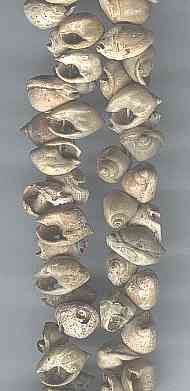The Bead Site =Home >Ancient Beads>The Oldest Beads> Why Beads?
Why Beads Were Even Made
Along with the question of which beads are the oldest, the question as to why people even began making beads arises. In the case of ostrich eggshell beads (the oldest in Africa at nearly 40,000 years old), Stanley Ambrose, their excavator, noted the use of these beads in present-day !Kung San society and suggested:
One may further speculate that if ostrich eggshell beads reflect an enhanced symbolic system of socially mediated risk-minimization and social solidarity, this may have facilitated population increase in Africa, the spread of modern humans out of Africa and the replacement of archaic human populations in Eurasia.
|
Some very interesting observations on why beads were first used were made by the authors of the paper:
The fact that traditions of ornament making emerged almost simultaneously in [this period] on three continents argues strongly against their corresponding to a specific event in the cognitive evolution of a single population.
If parallels can be drawn with recent human societies, beads and pendants may have been used in the [distant past] to communicate social identity, such as group membership, gender, and individual life-history characteristics (age, marital status, etc.)
[W]e might expect ornament technology to arise first where the chances of meeting strangers, and the benefits of advertising one's identity and status from afar, were relatively high. The near-simultaneous appearance of traditions involving redundant, standardized ornament forms may reflect critical local thresholds in human demography as human populations in these areas reached sizes at which new forms of communication became advantageous.
Note that both Ambrose and Kuhn et al. Emphasize the social role played by beads (they are not just pretty gewgaws). Yet, they put a slightly different spin on it. Ambrose suggests that beads facilitated population increase and expansion while Kuhn et al. suggest that bead use arose because of population increase. These two ideas are not necessarily mutually exclusive.
REFERENCE
Steven L. Kuhn, Mary C. Stiner, David S. Reese, and Erksin Güleç (2001) Ornaments of the earliest Upper Paleolithic: New insights from the Levant. Proceedings of the National Academy of Sciences 98(13): 7641-7646.
__________________________________________________
Small Bead Businesses | Beading & Beadwork | Ancient Beads | Trade Beads
Beadmaking & Materials | Bead Uses | Researching Beads | Beads and People
Center for Bead Research | Book Store | Free Store | Bead Bazaar
Shopping Mall | The Bead Auction | Galleries | People | Events
The Bead Site Home | Chat Line | Contact Us | Site Search Engine | FAQ
